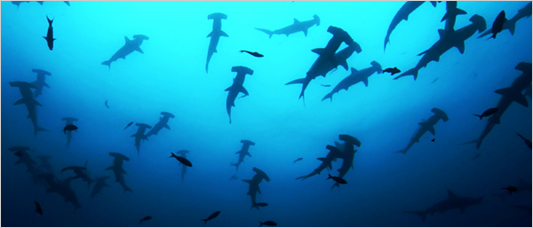Shark Finning. Will a ban stimulate population growth?
Posted by Jack Hollins on November 27, 2013
An article about an issue of global importance - the act of Shark Finning. This not only threatens the species involved, but has overarching implications on the well-being of all marine life and ecosystems. And since our (humans) survival depends, to a very large extent, on the ocean – also a very real threat to us.
Of all the threats that sharks currently face, the act of finning is the most notorious. Its excessive brutal nature has garnered the attention of both the media and the public, and a ban on shark finning is universal among the agendas of marine life conservation groups worldwide. As a result, 27 countries and the European Union now demand that any sharks caught be landed whole, with fins attached, effectively banning finning by vessels registered in those respective countries.
But, is this attention proportionate to the threat finning poses to shark populations? In the light of climate change, habitat loss, and poorly managed fisheries, will the ending of shark finning really give the many diminished shark populations the opportunity they need to recover? In order to address this, the act of shark finning must first be properly defined: ‘Finning’ is considered by many to be the removal of any shark’s fins, alive or dead, at sea or in port. In reality, shark finning involves the removal of the shark’s fins at sea, and discarding the often still living animal at sea to die of asphyxiation or blood loss.
Shark fin soup
The dish has traditionally only been consumed at special occasions by the very wealthy in China and so demand was typically low. However, due to the industrialisation of China, the wealth of its citizens increased and subsequently, the desire for shark fin soup. The barbaric practice of shark finning is encouraged by the exceptionally high market value of a shark’s fins in comparison to its meat. As a result of the high demand for the Chinese delicacy ‘shark fin soup’ - which contains no nutritional value nor have a remarkable taste- fishermen can expect to receive up to US$400 per kilogram for shark fin.
Population figures: The truth
It is this demand for soup, and the high prices it commands, which is often attributed to the population declines in many species of sharks worldwide. It is frequently reported that 100 million sharks are killed each year for their fins, a figure popularised by conservation organisations and documentaries. It is unclear where this figure came from, and it is unlikely that we will ever have a true value for the number of sharks finned each year.
The most accurate estimate of the amount of fins entering the global shark fin trade comes from a 2006 paper by Dr Shelley Clarke. In this paper, Dr Clarke found that the fins of between 26 and 73 million sharks ended up on the shark fin market, with an average number of 38 million. An important distinction to be made here is that nowhere in this paper does Dr Clarke state that all of these sharks were subjected to shark finning. Many of these sharks may have been landed in some of the most well managed shark fisheries in the world, while others may have been harvested in fisheries that are almost entirely unregulated. As such, it is important to remember that shark finning is not synonymous with the global shark fin trade. So the question must be asked, are bans on shark finning and the ownership and sale of shark fin really an efficient way to help sharks?
A simple answer would be ‘yes’. The disposal of the shark’s finless bodies at sea means that even small fishing vessels can overfish populations of sharks at regional and local scales, while this retention of only fins often makes the identification of landed species exceptionally difficult for managers. Either of these issues would render effective management of a shark fishery impossible, and so enforcing a shark fin ban would be an important first step in ensuring a healthy population of any species of shark. However, without other proper regulations in place, a shark fin ban would be of little use. In a paper recently authored by shark researchers including Dr Boris Worm, shark landings were estimated at 100 million individuals a year but could be as high as 273million. This means that between 6.4% and 7.9% of all sharks are killed each year. Such numbers would be alarming for any species, but are particularly devastating for shark populations owing to their low reproductive rates. Sharks reach sexually maturity at an old age compared to many fish species, some taking as long as 30 years to mature, and give birth to few young. This renders their recovery rates well below that at which they are being removed from the ocean.
BAN SHARK FINNING
Banning practice of shark finning is essential to the proper management of shark fisheries. The bans implemented in areas such as the EU, which was previously the largest exporter of shark fins in the world, will undoubtedly prove to be landmark events in shark conservation while increasing awareness of the plight of sharks has driven demand for shark fin soup down by 70% in China.
However, there are many threats to shark populations worldwide, which receive comparatively limited exposure through conservation groups, whose sole purpose can sometimes be the cessation of shark finning. While such groups are undoubtedly well meaning, the pervasive nature, and often poor understanding of threats such as climate change, habitat loss, and indiscriminate and unregulated fishing practices means that they now too require the enthusiasm of the shark conservation community. In this, and my later blog posts, I hope to go into some more detail about the nature of these threats, and the work that researchers worldwide are doing to mitigate them.
To be continued...


